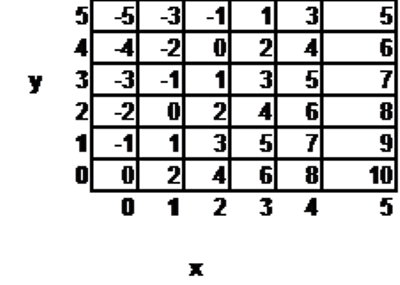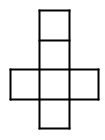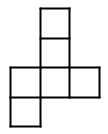Hints will display for most wrong answers; explanations for most right answers. You can attempt a question multiple times; it will only be scored correct if you get it right the first time.
I used the official objectives and sample test to construct these questions, but cannot promise that they accurately reflect what’s on the real test. Some of the sample questions were more convoluted than I could bear to write. See terms of use. See the MTEL Practice Test main page to view questions on a particular topic or to download paper practice tests.
MTEL General Curriculum Mathematics Practice
Question 1 |
Use the table below to answer the question that follows:

Each number in the table above represents a value W that is determined by the values of x and y. For example, when x=3 and y=1, W=5. What is the value of W when x=9 and y=14? Assume that the patterns in the table continue as shown.
\( \large W=-5\) Hint: When y is even, W is even. | |
\( \large W=4\) Hint: Note that when x increases by 1, W increases by 2, and when y increases by 1, W decreases by 1. At x=y=0, W=0, so at x=9, y=14, W has increased by \(9 \times 2\) and decreased by 14, or W=18-14=4. | |
\( \large W=6\) Hint: Try fixing x or y at 0, and start by finding W for x=0 y=14 or x=9, y=0. | |
\( \large W=32\) Hint: Try fixing x or y at 0, and start by finding W for x=0 y=14 or x=9, y=0. |
Question 2 |
Use the expression below to answer the question that follows.
\(\large \dfrac{\left( 155 \right)\times \left( 6,124 \right)}{977}\)
Which of the following is the best estimate of the expression above?
100Hint: 6124/977 is approximately 6. | |
200Hint: 6124/977 is approximately 6. | |
1,000Hint: 6124/977 is approximately 6. 155 is approximately 150, and \( 6 \times 150 = 3 \times 300 = 900\), so this answer is closest. | |
2,000Hint: 6124/977 is approximately 6. |
Question 3 |
The histogram below shows the number of pairs of footware owned by a group of college students.

Which of the following statements can be inferred from the graph above?
The median number of pairs of footware owned is between 50 and 60 pairs.Hint: The same number of data points are less than the median as are greater than the median -- but on this histogram, clearly more than half the students own less than 50 pairs of shoes, so the median is less than 50. | |
The mode of the number of pairs of footware owned is 20.Hint: The mode is the most common number of pairs of footwear owned. We can't tell it from this histogram because each bar represents 10 different numbers-- perhaps 8 students each own each number from 10 to 19, but 40 students own exactly 6 pairs of shoes.... or perhaps not.... | |
The mean number of pairs of footware owned is less than the median number of pairs of footware owned.Hint: This is a right skewed distribution, and so the mean is bigger than the median -- the few large values on the right pull up the mean, but have little effect on the median. | |
The median number of pairs of footware owned is between 10 and 20.Hint: There are approximately 230 students represented in this survey, and the 41st through 120th lowest values are between 10 and 20 -- thus the middle value is in that range. |
Question 4 |
Which of the numbers below is not equivalent to 4%?
\( \large \dfrac{1}{25}\) Hint: 1/25=4/100, so this is equal to 4% (be sure you read the question correctly). | |
\( \large \dfrac{4}{100}\) Hint: 4/100=4% (be sure you read the question correctly). | |
\( \large 0.4\) Hint: 0.4=40% so this is not equal to 4% | |
\( \large 0.04\) Hint: 0.04=4/100, so this is equal to 4% (be sure you read the question correctly). |
Question 5 |
Which of the following nets will not fold into a cube?
 Hint: If you have trouble visualizing, cut them out and fold (during the test, you can tear paper to approximate). | |
 | |
 Hint: If you have trouble visualizing, cut them out and fold (during the test, you can tear paper to approximate). | |
 Hint: If you have trouble visualizing, cut them out and fold (during the test, you can tear paper to approximate). |
Question 6 |
The polygon depicted below is drawn on dot paper, with the dots spaced 1 unit apart. What is the perimeter of the polygon?

\( \large 18+\sqrt{2} \text{ units}\) Hint: Be careful with the Pythagorean Theorem. | |
\( \large 18+2\sqrt{2}\text{ units}\) Hint: There are 13 horizontal or vertical 1 unit segments. The longer diagonal is the hypotenuse of a 3-4-5 right triangle, so its length is 5 units. The shorter diagonal is the hypotenuse of a 45-45-90 right triangle with side 2, so its hypotenuse has length \(2 \sqrt{2}\). | |
\( \large 18 \text{ units}
\) Hint: Use the Pythagorean Theorem to find the lengths of the diagonal segments. | |
\( \large 20 \text{ units}\) Hint: Use the Pythagorean Theorem to find the lengths of the diagonal segments. |
Question 7 |
A family went on a long car trip. Below is a graph of how far they had driven at each hour.

Which of the following is closest to their average speed driving on the trip?
\( \large d=20t\) Hint: Try plugging t=7 into the equation, and see how it matches the graph. | |
\( \large d=30t\) Hint: Try plugging t=7 into the equation, and see how it matches the graph. | |
\( \large d=40t\) | |
\( \large d=50t\) Hint: Try plugging t=7 into the equation, and see how it matches the graph. |
Question 8 |
The histogram below shows the frequency of a class's scores on a 4 question quiz.

What was the mean score on the quiz?
\( \large 2.75\) Hint: There were 20 students who took the quiz. Total points earned: \(2 \times 1+6 \times 2+ 7\times 3+5 \times 4=55\), and 55/20 = 2.75. | |
\( \large 2\) Hint: How many students are there total? Did you count them all? | |
\( \large 3\) Hint: How many students are there total? Did you count them all? Be sure you're finding the mean, not the median or the mode. | |
\( \large 2.5\) Hint: How many students are there total? Did you count them all? Don't just take the mean of 1, 2, 3, 4 -- you have to weight them properly. |
Question 9 |
A sales companies pays its representatives $2 for each item sold, plus 40% of the price of the item. The rest of the money that the representatives collect goes to the company. All transactions are in cash, and all items cost $4 or more. If the price of an item in dollars is p, which expression represents the amount of money the company collects when the item is sold?
\( \large \dfrac{3}{5}p-2\) Hint: The company gets 3/5=60% of the price, minus the $2 per item. | |
\( \large \dfrac{3}{5}\left( p-2 \right)\) Hint: This is sensible, but not what the problem states. | |
\( \large \dfrac{2}{5}p+2\) Hint: The company pays the extra $2; it doesn't collect it. | |
\( \large \dfrac{2}{5}p-2\) Hint: This has the company getting 2/5 = 40% of the price of each item, but that's what the representative gets. |
Question 10 |
An above-ground swimming pool is in the shape of a regular hexagonal prism, is one meter high, and holds 65 cubic meters of water. A second pool has a base that is also a regular hexagon, but with sides twice as long as the sides in the first pool. This second pool is also one meter high. How much water will the second pool hold?
\( \large 65\text{ }{{\text{m}}^{3}}\) Hint: A bigger pool would hold more water. | |
\( \large 65\cdot 2\text{ }{{\text{m}}^{3}}\) Hint: Try a simpler example, say doubling the sides of the base of a 1 x 1 x 1 cube. | |
\( \large 65\cdot 4\text{ }{{\text{m}}^{3}}\) Hint: If we think of the pool as filled with 1 x 1 x 1 cubes (and some fractions of cubes), then scaling to the larger pool changes each 1 x 1 x 1 cube to a 2 x 2 x 1 prism, or multiplies volume by 4. | |
\( \large 65\cdot 8\text{ }{{\text{m}}^{3}}\) Hint: Try a simpler example, say doubling the sides of the base of a 1 x 1 x 1 cube. |
Question 11 |
On a map the distance from Boston to Detroit is 6 cm, and these two cities are 702 miles away from each other. Assuming the scale of the map is the same throughout, which answer below is closest to the distance between Boston and San Francisco on the map, given that they are 2,708 miles away from each other?
21 cmHint: How many miles would correspond to 24 cm on the map? Try adjusting from there. | |
22 cmHint: How many miles would correspond to 24 cm on the map? Try adjusting from there. | |
23 cmHint: One way to solve this without a calculator is to note that 4 groups of 6 cm is 2808 miles, which is 100 miles too much. Then 100 miles would be about 1/7 th of 6 cm, or about 1 cm less than 24 cm. | |
24 cmHint: 4 groups of 6 cm is over 2800 miles on the map, which is too much. |
Question 12 |
A teacher has a list of all the countries in the world and their populations in March 2012. She is going to have her students use technology to compute the mean and median of the numbers on the list. Which of the following statements is true?
The teacher can be sure that the mean and median will be the same without doing any computation.Hint: Does this make sense? How likely is it that the mean and median of any large data set will be the same? | |
The teacher can be sure that the mean is bigger than the median without doing any computation.Hint: This is a skewed distribution, and very large countries like China and India contribute huge numbers to the mean, but are counted the same as small countries like Luxembourg in the median (the same thing happens w/data on salaries, where a few very high income people tilt the mean -- that's why such data is usually reported as medians). | |
The teacher can be sure that the median is bigger than the mean without doing any computation.Hint: Think about a set of numbers like 1, 2, 3, 4, 10,000 -- how do the mean/median compare? How might that relate to countries of the world? | |
There is no way for the teacher to know the relative size of the mean and median without computing them.Hint: Knowing the shape of the distribution of populations does give us enough info to know the relative size of the mean and median, even without computing them. |
Question 13 |
How many factors does 80 have?
\( \large8\) Hint: Don't forget 1 and 80. | |
\( \large9\) Hint: Only perfect squares have an odd number of factors -- otherwise factors come in pairs. | |
\( \large10\) Hint: 1,2,4,5,8,10,16,20,40,80 | |
\( \large12\) Hint: Did you count a number twice? Include a number that isn't a factor? |
Question 14 |
Use the table below to answer the question that follows:
Gordon wants to buy three pounds of nuts. Each of the stores above ordinarily sells the nuts for $4.99 a pound, but is offering a discount this week. At which store can he buy the nuts for the least amount of money?
Store AHint: This would save about $2.50. You can quickly see that D saves more. | |
Store BHint: This saves 15% and C saves 25%. | |
Store C | |
Store DHint: This is about 20% off, which is less of a discount than C. |
Question 15 |
Which of the lists below contains only irrational numbers?
\( \large\pi , \quad \sqrt{6},\quad \sqrt{\dfrac{1}{2}}\) | |
\( \large\pi , \quad \sqrt{9}, \quad \pi +1\) Hint: \( \sqrt{9}=3\) | |
\( \large\dfrac{1}{3},\quad \dfrac{5}{4},\quad \dfrac{2}{9}\) Hint: These are all rational. | |
\( \large-3,\quad 14,\quad 0\) Hint: These are all rational. |
Question 16 |
P is a prime number that divides 240. Which of the following must be true?
P divides 30Hint: 2, 3, and 5 are the prime factors of 240, and all divide 30. | |
P divides 48Hint: P=5 doesn't work. | |
P divides 75Hint: P=2 doesn't work. | |
P divides 80Hint: P=3 doesn't work. |
Question 17 |
Use the problem below to answer the question that follows:
T shirts are on sale for 20% off. Tasha paid $8.73 for a shirt. What is the regular price of the shirt? There is no tax on clothing purchases under $175.
Let p represent the regular price of these t-shirt. Which of the following equations is correct?
\( \large 0.8p=\$8.73\) Hint: 80% of the regular price = $8.73. | |
\( \large \$8.73+0.2*\$8.73=p\) Hint: The 20% off was off of the ORIGINAL price, not off the $8.73 (a lot of people make this mistake). Plus this is the same equation as in choice c. | |
\( \large 1.2*\$8.73=p\) Hint: The 20% off was off of the ORIGINAL price, not off the $8.73 (a lot of people make this mistake). Plus this is the same equation as in choice b. | |
\( \large p-0.2*\$8.73=p\) Hint: Subtract p from both sides of this equation, and you have -.2 x 8.73 =0. |
Question 18 |
Each individual cube that makes up the rectangular solid depicted below has 6 inch sides. What is the surface area of the solid in square feet?

\( \large 11\text{ f}{{\text{t}}^{2}}\) Hint: Check your units and make sure you're using feet and inches consistently. | |
\( \large 16.5\text{ f}{{\text{t}}^{2}}\) Hint: Each square has surface area \(\dfrac{1}{2} \times \dfrac {1}{2}=\dfrac {1}{4}\) sq feet. There are 9 squares on the top and bottom, and 12 on each of 4 sides, for a total of 66 squares. 66 squares \(\times \dfrac {1}{4}\) sq feet/square =16.5 sq feet. | |
\( \large 66\text{ f}{{\text{t}}^{2}}\) Hint: The area of each square is not 1. | |
\( \large 2376\text{ f}{{\text{t}}^{2}}\) Hint: Read the question more carefully -- the answer is supposed to be in sq feet, not sq inches.
|
Question 19 |
The pattern below consists of a row of black squares surrounded by white squares.

How many white squares would surround a row of 157 black squares?
314Hint: Try your procedure on a smaller number that you can count to see where you made a mistake. | |
317Hint: Are there ever an odd number of white squares? | |
320Hint: One way to see this is that there are 6 tiles on the left and right ends, and the rest of the white tiles are twice the number of black tiles (there are many other ways to look at it too). | |
322Hint: Try your procedure on a smaller number that you can count to see where you made a mistake. |
Question 20 |
In which table below is y a function of x?
 Hint: If x=3, y can have two different values, so it's not a function. | |
 Hint: If x=3, y can have two different values, so it's not a function. | |
 Hint: If x=1, y can have different values, so it's not a function. | |
 Hint: Each value of x always corresponds to the same value of y. |
|
List |
If you found a mistake or have comments on a particular question, please contact me (please copy and paste at least part of the question into the form, as the numbers change depending on how quizzes are displayed). General comments can be left here.
